German-American Encounters in Bavaria and Beyond, 1945–2015
Summary
Excerpt
Table Of Contents
- Cover
- Title
- Copyright
- About the author(s)/editor(s)
- About the book
- This eBook can be cited
- Contents
- Preface
- Overture: The Transnational Epistemologies of Flossenbürg (Jörg Skriebeleit / Birgit M. Bauridl)
- ‘A World Carefully Faked for Our Coming’: German-American Encounters in 1940s Bavaria (and Beyond) (Werner Sollors)
- Encounters between Germans, Americans, and Eastern Europeans in a Changing Friend-Foe Relationship: The City of Regensburg around 1945 (Roman Smolorz in collaboration with Florian Weinzierl)
- Abe Meets Alois: Post-1945 Bavarian (Re-)Education (Heike Paul)
- From Reeducation to Partnership: Amerikahäuser and German-American Institutes in Bavaria (Reinhild Kreis)
- “Isn’t there a ghost in this romantic old castle?” American Studies at Salzburg’s Schloss Leopoldskron (Ralph J. Poole)
- At War’s End: American Perspectives and German Dispositions in Ludwig Bemelmans’ The Blue Danube, Saul K. Padover’s Experiment in Germany, and G. M. Gilbert’s Nuremberg Diary (Zeno Ackermann)
- Transatlantic Romance(s) of the Postwar Years: Interracial Relationships in Die PX-Story (1959) and Transgression (2015) (Katharina Gerund)
- Obersalzberg from 1945 until Today: German-American Encounters below the Eagle’s Nest (Albert A. Feiber / Ingrid Gessner)
- 51st State: A Photographic Encounter with Soldiers of the U.S. Army and Their Families in Bavaria (Lila Hartig / Moritz Kienast)
- The Kaiserslautern Borderland—The United States in Rhineland-Palatinate (Jörg Zorbach)
- Playing Cowboys and Indians in the Bavarian Forest: Pullman City, ‘the Living Western Town’ (Karsten Fitz)
- Fantasies of the Wild West in the Austrian 1990s: Harald Sicheritz’ Wanted (Leopold Lippert)
- “Bouncin’ in Bavaria”: Remapping the Lingua Franca of Jazz in Postwar Germany and the Netherlands (Frank Mehring)
- Editors and Contributors
The volume emerged from the international conference “1945–2015: German-American Encounters in Bavaria” organized by the Regensburg European American Forum (REAF) in cooperation with the Flossenbürg Concentration Camp Memorial. The symposium was held from 11 to 13 June 2015 in the rooms of the former Deutsch-Amerikanisches Institut Regensburg in the Thon-Dittmer-Palais in the center of the UNESCO World Heritage city of Regensburg, at the seminar center of the Flossenbürg Concentration Camp Memorial, and at the conference venue Altes Finanzamt of the University of Regensburg.
The fourteen contributions to the collection of essays, five of them papers originally given at the 2015 conference and nine of them additionally written for inclusion in the present publication, draw on the conceptual frameworks of Transnational American Studies to explore manifestations and specificities of German-American encounters in the particular region of Bavaria since the end of World War II. From the liberation of Germany from the Nazi regime in 1945 and the ensuing endeavors of denazification and re-education through the following decades of changing geopolitical parameters and increasingly global political, economic, social, and cultural interaction, the American presence in the southeastern German state of Bavaria has remained especially tangible. Over the course of more than seventy years German-American encounters in Bavaria have left a remarkably visible impact on fields as diverse, complex, and possibly conflict-driven as military cooperation, economic and social interaction, cultural diplomacy, cultural representation, memorial culture, regional folk culture, and tourism.
The articles gathered here span historical and thematic trajectories of transnational entanglements which begin with immediate post-World War II encounters of different kinds, include diverse political, social, and cultural agendas and efforts at the intersections of historical guilt, memory, and trans/national identity politics of various American, German, and Bavarian interests, and range to contemporary contact zones of German-American political, social, and cultural negotiations. The focus on ‘German-American encounters in Bavaria,’ together with the articles engaging similar issues and phenomena in the western German state of Rhineland-Palatinate, in Austria, and in the Netherlands, complicates bipolar, possibly essentializing comparative approaches in favor of more multidirectional and more multivocal conceptualizations of transnational interactions and cultural transfer in particular regions and localities. ← 7 | 8 →
The conference and the volume received generous support from many people and institutions. The editors wish to thank all speakers at the 2015 conference and all contributors to the collection of essays. Florian Weinzierl and the research assistants of the Chair of American Studies of the University of Regensburg competently helped see the manuscripts through the editorial process. Special words of gratitude go to the University of Regensburg, the Flossenbürg Concentration Camp Memorial, the Heilpädagogische Zentrum Irchenrieth, and the U.S. Embassy Berlin.
We are delighted that the Bayerisches Staatsministerium der Finanzen, für Landesentwicklung und Heimat granted the copyright to reproduce the photograph of illuminated Schloss Neuschwanstein on the cover. This image provides a glimpse into the week-long, daily alternating projections of the national flags of the G7 nations in the lead-up to their summit at nearby Schloss Elmau, Krün, on 7–8 June 2015. The colorful interplay of the laser projection of the national flags of the United States of America, Germany, and other G7 summit participants—as well as the state flag of Bavaria—on the silhouette of one of Bavaria’s most famous locations and international tourist attractions on the occasion of the locally, nationally, and globally contested G7 summit manifests the multiperspectival and multicontextual approach, agenda, and awareness of the present volume and its individual contributions.
Regensburg, January 2018
Birgit M. Bauridl – Ingrid Gessner – Udo J. Hebel
Overture: The Transnational Epistemologies of Flossenbürg
Fig. 1: Permanent exhibition ‘Flossenbürg Concentration Camp 1938–1945.’ Flossenbürg Concentration Camp Memorial, 2017.

Flossenbürg from and beyond an American Studies Perspective
On 23 April 1945 soldiers of the U.S. Army Infantry reached the Flossenbürg Concentration Camp in the rural and remote realms of Bavaria, not far from the later Iron Curtain. The U.S. soldiers faced scenes of horror and misanthropy impossible to imagine, yet nevertheless common vistas on the Allied forces’ routes of liberation through Hitler’s Germany. Just a few days earlier, the SS had begun to hide traces of their petrifying actions, had, upon Hitler’s explicit horrendous desire, killed some of his so-called personal prisoners like Dietrich Bonhoeffer or Wilhelm Canaris, and had initiated death marches of more than 40,000 prisoners that would leave a trail of human corpses along its pathways. When the 90th and 97th Divisions arrived, they encountered some 1,500 prisoners still remaining in Flossenbürg. Their relief was inadvertently juxtaposed with the deathly tools and dead bodies left behind in Flossenbürg and beyond (see esp. Skriebeleit) (figs. 1–5). ← 9 | 10 →
Fig. 2: Permanent exhibition ‘what remains: The Aftermath of the Flossenbürg Concentration Camp.’ Flossenbürg Concentration Camp Memorial, 2017.
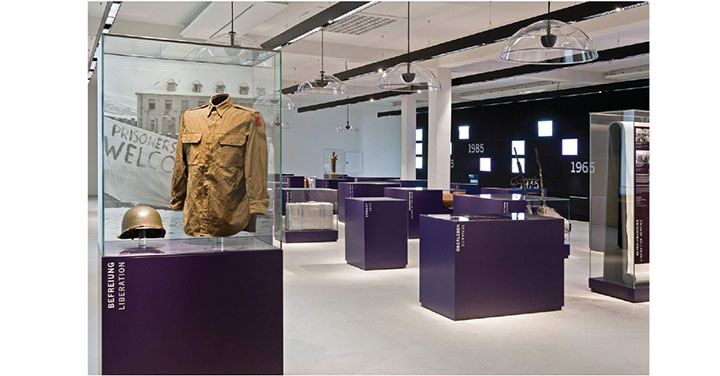
Fig. 3: Helen Patton, daughter of General George S. Patton, at the 65th anniversary of the liberation of Flossenbürg Concentration Camp on 23 April 2010.
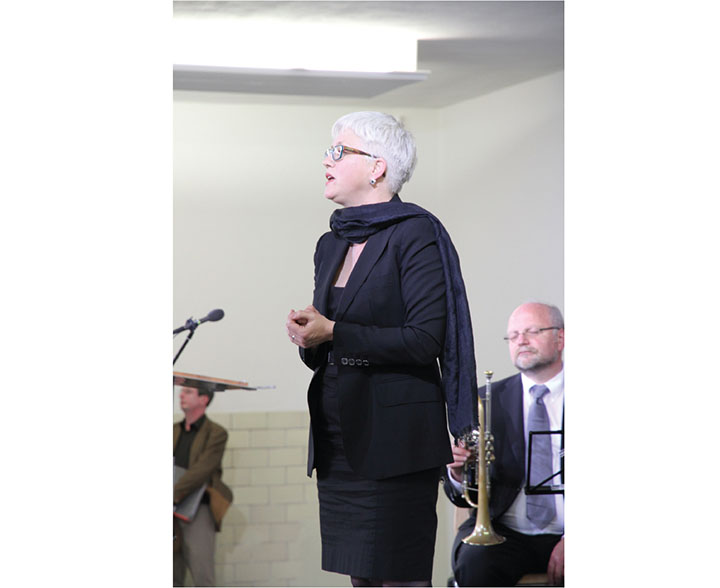
Fig. 4: Examination of the liberated Flossenbürg Concentration Camp by a U.S. Army investigation team. U.S. Army Signal Corps, 30 April 1945.
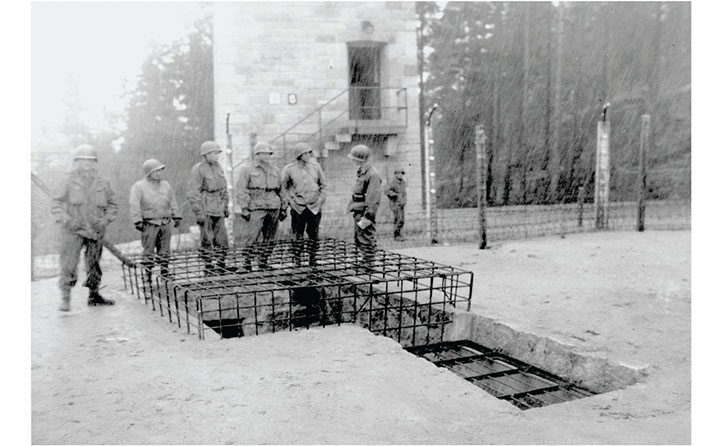
Fig. 5: Exhumation of murdered prisoners along one of the death march routes. U.S. Army Signal Corps, 1945.
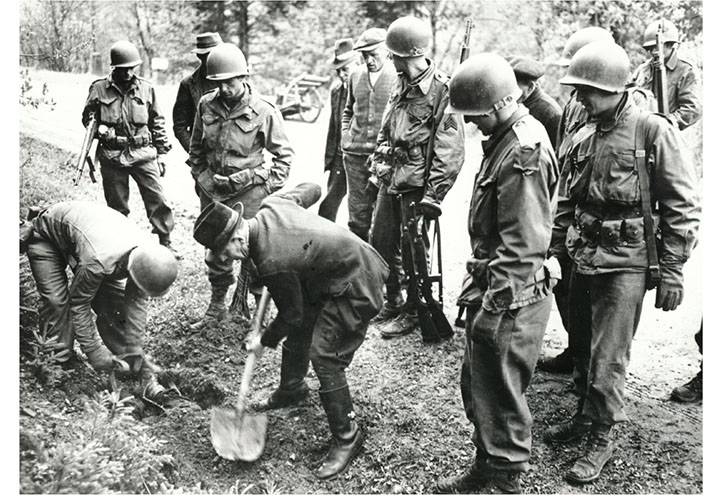
On 12 June 2015, 70 years after the end of World War II, a group of international scholars, mostly Americanists, graduate students, and staff of the Flossenbürg Concentration Camp Memorial met on site in Flossenbürg on the occasion of a conference on German-American encounters in Bavaria since 1945. The conference (fig. 6)—scholarly, but also quite literally—took us along the trajectories of German-American encounters and brought us to the former Deutsch-Amerikanisches Institut in the historic downtown area of the City of Regensburg and to the just recently established seminar center of the KZ-Gedenkstätte Flossenbürg. At the location of the former SS Officers’ Casino (see fig. 18)—a site demanding a priori a responsible awareness of and engagement with the past—, the group engaged in discussions that are reflected by the contributions to this conference volume. The museum café’s catering was organized by a Werkstätte of the Heilpädagogisches Zentrum Irchenrieth (center for therapeutic pedagogy)—a subtle, yet open counter action to the history of the place.
Fig. 6: Conference poster ‘1945–2015: German-American Encounters in Bavaria,’ 11–13 June 2015. Regensburg European American Forum (REAF) in cooperation with Flossenbürg Concentration Camp Memorial.

On 23 April 2017, 72 years after the end of World War II and one year before this volume’s publication, a diverse group of survivors, relatives, witnesses, musicians, young students, German, American, and international political and cultural, national and communal representatives gathered at the Flossenbürg Concentration Camp Memorial to commemorate and celebrate the 72nd anniversary of its liberation (fig. 7). On the site of the former atrocities, the community gathered for the commemorative enactment in the here and now, engaged in testimonies of the past and present to pay tribute to the guilt and trauma inherent in the site, but also to embody, visualize, and transmit its potential and power as a site of drafting responsible and joint visions for the future.
Fig. 7: 72nd anniversary of the liberation of Flossenbürg Concentration Camp, with wreath-laying ceremony at the Square of Nations, 23 April 2017.

On 11 and 12 August 2017, 72 years after Flossenbürg’s liberation from the atrocities of Nazi terror, hundreds of white supremacists, Nazi groups, and KKK affiliates flocked together in the American town of Charlottesville for a ‘Unite the Right’ march after a statue of Robert E. Lee, a Civil War General and supporter of slavery, had been removed. The rallies shattered the Virginia city of 50,000 inhabitants with violent turmoil and chaos and with blatant and contemptuous displays of hate, racism, and KKK and Nazi symbolism. Counter protesters were ← 13 | 14 → met with violence, among them Heather Heyer, who was killed by an attacking car. Seventy-two years after the end of World War II and thousands of miles away from Flossenbürg, Charlottesville became the epitome of a misanthropic, scornful, and violent mindset that divides the United States in the age of Donald J. Trump.
These scenes between 1945 and 2017 mark the trajectories that link Flossenbürg and American Studies and the intersections between the memorial site and scholarly research on German-American encounters in Bavaria since 1945. Flossenbürg may be viewed as an exemplary history and space for as well as a prismatic condensation of the beginning of the large-scale American presence in the Upper Palatinate region and in the German state of Bavaria. While the moment of liberation points to the encounter of German perpetrators, multi-national victims, and American liberators, the postwar years are characterized by the German-American encounters of occupation; re-education; a growing alliance between Germans and Americans in the region bordering the Czech Republic during the Cold War; and a continued, especially economic, symbiosis between Americans and Germans until today. In other words, the paradigmatic encounter of liberation can be approached as the starting point of German-American encounters in this particular Bavarian region. Synchronically, the Grafenwoehr Training Area, just a few miles away from Flossenbürg, still constitutes one of the largest U.S. military training facilities in Europe and, hence, also impacts the region with a large civilian and cultural American presence. That this presence also shapes processes of ‘Bavarian’ self-identification in relation to ‘America’ and ‘Americans’ in the region can best be illustrated with the example of Elvis Presley. The American celebrity and allegedly most famous GI spent several weeks at the rural Grafenwoehr Training Area during the Cold War years. He not only triggered major turmoil among the region’s young population back then but continues to be appropriated as an empowering ally and quasi-Bavarian in local exhibitions, e.g., in Burglengenfeld in 2012 and in Grafenwoehr more recently in 2017. The ongoing existence of Amerikahäuser, e.g., in Munich; baseball teams, e.g., in Regensburg; ‘Cowboys-and-Indians’ theme parks such as Pullman City near Passau; the Grafenwoehr German-American Volksfest drawing up to 150,000 visitors annually; and the only original World Trade Center steel beam in Europe located in the rural Bavarian town of Oberviechtach, likewise just a few miles from Flossenbürg, bear testimony to an ongoing and defining context of German-American encounters. The American presence reflects back on the memorial site of Flossenbürg. It is just a 35-minute drive from the American housing areas of Grafenwoehr to Flossenbürg. Hence it comes as no surprise that Flossenbürg is on the cultural bucket list of many Americans in the region; that U.S. military representatives were among the guests for the 2017 commemoration of liberation day; or that on the occasion of the American Memorial Day, Americans from Grafenwoehr, for example ← 14 | 15 → a group of Club and Boy Scouts and veterans, came to Flossenbürg in a gesture of respect and commemoration (see fig. 22; figs. 8–9).
Figs. 8 and 9: Memorial Day in Flossenbürg, 29 May 2017.

It would be reductive to limit Flossenbürg to the sphere of German-American relations. The transnational routes that rotate from the transnational turntable (Hebel) of Flossenbürg as a historical and contemporary space are complex, multifarious, and oftentimes entangled. Flossenbürg needs not only be situated at the atrocious end of Mary Louise Pratt’s widely circulated definition of the contact zone as a “social space[] where cultures meet, clash, and grapple with each other, often in highly asymmetrical relations of power, such as colonialism, slavery, or their aftermaths” (34). As a concentration camp, before the arrival of the American liberators, Flossenbürg already, and forcefully so, brought together inmates from diverse cultural and national backgrounds. When as a memorial site today it unites (relatives of) former inmates from all around the globe—100,000 prisoners from 47 nations—, e.g., Jack Terry, speaker for the former prisoners of the Flossenbürg concentration camp, official political and cultural representatives, tourists, and local audiences, it becomes a space of multifarious transnational encounters. Actually, Flossenbürg may well be grasped with the ideas of triangular (Desmond) or transangular (Bauridl and Hebel) American Studies—ideas that, respectively, highlight the interaction and intersection as well as the entanglement and possible amalgamation of more than two players in transnational processes. As a space of multiple cultural and national affiliations, interests, identifications, and appropriations—and consequently of multiple interpretations and definitions—Flossenbürg may be approached via the idea of the transnational prism. In Jane Desmond’s seminal call for “prismatic American Studies,” her concept of the prism—more abstractly than the more concrete employment for Flossenbürg—expressed the desire for an approach to the United States as an “interlocking set of imaginaries,” a flexible set of “multiple coexisting illuminations coming from different angles of vision” (6). For the Americanist, Desmond’s prism and Flossenbürg demonstrate not only that a study of ‘America’ needs to acknowledge its multiple definitions and intersections but also that ‘America’ needs to be decentered in scholarly attempts to understand it (figs. 10–11). ← 16 | 17 →
Fig. 10: Jack Terry, survivor of Flossenbürg Concentration Camp, and Vernon Schmidt, liberator and veteran of the 90th Infantry Division, meet at the 70th anniversary of the liberation of Flossenbürg Concentration Camp, 23 April 2015.

Fig. 11: Details of the permanent exhibition ‘what remains: The Aftermath of the Flossenbürg Concentration Camp.’ Flossenbürg Concentration Camp Memorial, 2017.

Flossenbürg’s larger transnational dimension and Desmond’s idea of the prism also become obvious in Flossenbürg’s spatial design—which bears the (conscious) traces of its diachronic development over the decades. After its liberation, Flossenbürg continued to ‘function’—also due to the at times problematic pragmatism of the American Military Government—as a contact zone first as a camp for prisoners of war and, beginning in 1946, for displaced persons. Until today, the visitor standing on the concentration camp’s former Appellplatz (roll call grounds) sees the adjacent residential area, i.e. the former barrack area that in the 1950s was turned into housing and homes for displaced persons. Until today, the descendants of displaced persons literally cross the former concentration camp when driving out of their neighborhood. The first attempts to make Flossenbürg a commemorative space were, among others, made by Polish displaced persons as early as 1946 (see Skriebeleit). A Catholic church built from the stones of the former concentration camp towers point to the Catholic Polish initiators and, like the commemorative Valley of Death it is located in, is a reminder not only of the space’s pre-1945 past, but also of the years since then (fig. 15). The visual and architectural present of Flossenbürg bears the visible traces of its past. As an actual and tangible “deep space” (Bauridl in reference to Fishkin’s digital deep maps), Flossenbürg visualizes and architecturally lays bare its diverse cultural and national layers of its past; as a concrete site, it serves as a prismatic looking glass into the trajectories of its transnational history (figs. 12–13, 15).
Fig. 12: Projection on the animated model of the camp site at the permanent exhibition ‘Flossenbürg Concentration Camp 1938–1945.’ Flossenbürg Concentration Camp Memorial, 2017.
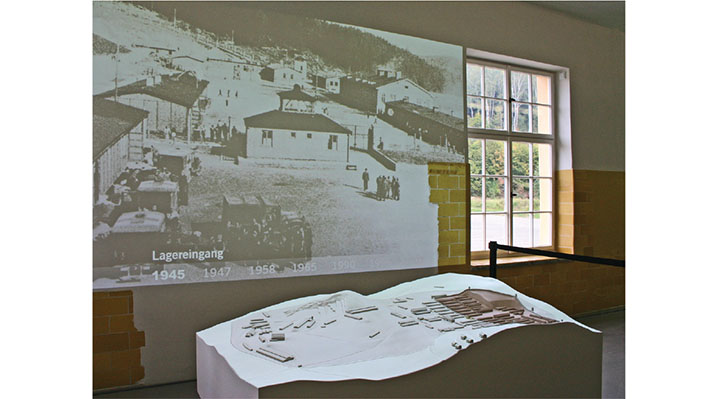
Fig. 13: View of the former pisoners area. Flossenbürg Concentration Camp Memorial, 2017.
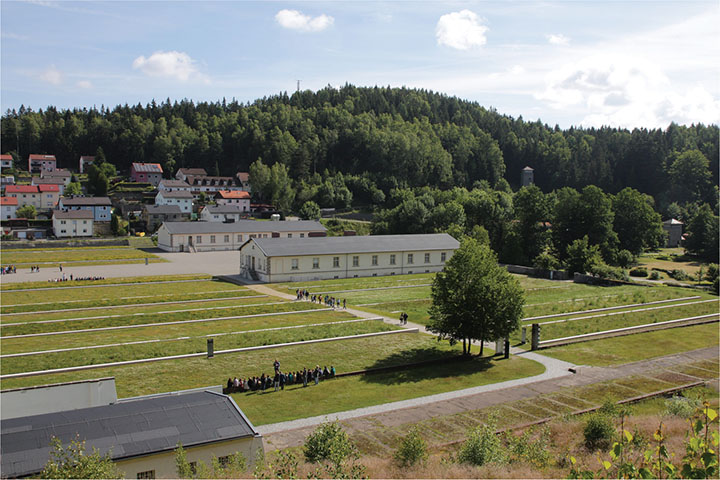
Today, Flossenbürg decidedly identifies itself as a ‘European site of memory’ and thus, in its self-definition, nods to both its transnational past and present. This self-naming also demonstrates that Flossenbürg as a site of memory is the result of a conscious attempt as well as an ongoing process. As the following essays and images about the history of Flossenbürg as a concentration camp and as a memorial site elucidate, Flossenbürg has, especially under the directorship of Jörg Skriebeleit, only in recent decades received its due construction and attention as a transnational site of memory located in a remote Bavarian area. As the memorial’s website notes: “When the survivors returned to Flossenbürg to commemorate 50 years of the camp’s liberation, they found houses, a small industrial zone and a cemetery, which resembled a park, on the site. The remains and traces of the concentration camp had been re-shaped and concealed in an almost unrecognizable way” (see page 23 in this article). Twenty-first century redesign includes the removal of the industrial buildings and a reconstruction that pays tribute to and makes visible the pre-liberation structures of the carefully crafted site of memory (see fig. 16). From a scholarly perspective, Flossenbürg openly acknowledges its construction and constructed-ness as a site of memory with the help of epistemologies offered by memory studies. Its transnational dimension exemplifies the urgency with which scholars of American Studies ← 19 | 20 → and memory studies have called for a more transnational approach to processes and phenomena of memory. In 2008 Udo J. Hebel notes: “As far as American(ist) memory studies are concerned, it seems that a creative synthesis of two recent turns, i.e. the transnational turn and the spatial turn, offers particularly promising perspectives for grounding American memory studies in the increasingly complex and challenging landscapes, structure, and processes of transnational exchange, competition, and conflict” (“Whereto American(ist) Memory Studies?” 395; see also De Cesari and Rigney; Rothberg).
Flossenbürg—in its relevance, impact, and conscious self-understanding—reflects the nature of memory as not turned backwards, but as looking to and drawing on the past in response to present needs and conditions and in order to create epistemologies that have the power to shape the present and the future (see Hebel; Sturken). These epistemologies may come and need to come in diverse manifestations that may range from scholarly and non-scholarly texts, to images, performances, materials, and tangible as well as digital spaces and which are open for diverse engagements—a phenomenon the format of this overture article approaches and reflects. It is in this sense that the two following texts adapted from the Flossenbürg Concentration Camp Memorial’s intermedial website as well as the respective images in this overture have been made available as a reflection and epistemology by the Flossenbürg Concentration Camp Memorial.
An American Studies approach to Flossenbürg, likewise, needs to come with more than just an interest in German-American relations of the past and a focus on American liberators. An American Studies perspective on Flossenbürg must not appropriate this site of knowledge—neither for descriptive academic re-tellings of an imperial American story nor for a monolithic reclaiming of a German-American joint history. An American Studies engagement with Flossenbürg needs to decenter the United States, pay homage to multiple transnational routes, and, above all, it must view itself as one possible discipline among many disciplines, viewpoints, and approaches to Flossenbürg. Like memory, which is rarely nostalgic and never located in the past, an American Studies approach to Flossenbürg needs to conduct a critical and responsible discussion about its potential for the present and future. When in 2017 Nazi symbols shape the streets of Charlottesville, this town in Virginia is an example for the Americanist’s responsibility to participate in the future-directed memory work of Flossenbürg via its own critical, responsible, scholarly, and political endeavor. Charlottesville is just one example for the inter- and multidisciplinary scholarly, for the political, social, and cultural, and for transnational trajectories and epistemologies of Flossenbürg. ← 20 | 21 →
Details
- Pages
- 320
- Year
- 2018
- ISBN (ePUB)
- 9783631709238
- ISBN (PDF)
- 9783653071573
- ISBN (MOBI)
- 9783631709245
- ISBN (Hardcover)
- 9783631679333
- DOI
- 10.3726/b14451
- Language
- English
- Publication date
- 2018 (October)
- Keywords
- transnational spaces cultural transfer post-WWII Bavaria cultural diplomacy memory German-American relations
- Published
- Berlin, Bern, Bruxelles, New York, Oxford, Warszawa, Wien. 2018. 49 col. ill., 13 b/w ill.

